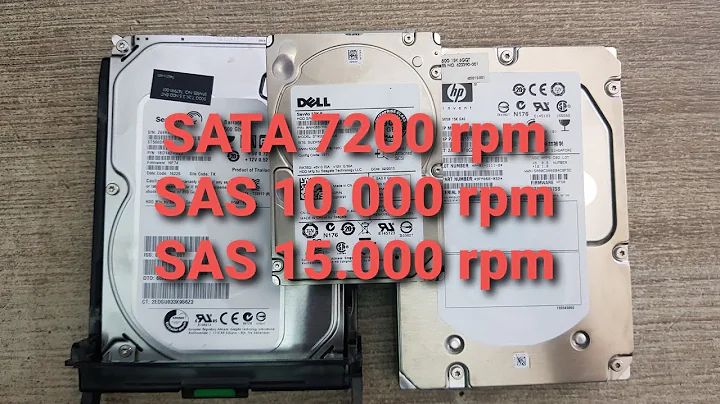What's the difference between 10k/15k SAS HDDs and SATA SSDs?
Discussion
At HDD: performance differences between 7.2k SATA and 15k SAS, we've determined that 7.2k RPM HDDs would have well under a 100 IOPS, whereas even 15k SAS would still only net you about 200 IOPS. (These IOPS parameters are limited by the speed of rotation, which stays constant through generations, and doesn't improve with each generation (unlike sequential throughput, which does improve with each generation).) Doing simple math around random 4K reads/writes, this translates to a performance metric of at most 800KiB/s — well under 1MiB/s.
Compare this with the specs for various SSDs that have been on the market for a number of years; generally, the SATA 6Gbps (600MiB/s) ones appear to have reached interface limit, as they all appear to be spec'ed to about 85k IOPS for both reads and writes. At random 4K read/write, that translates to 340MiB/s, which would appear to be faster than even the sequential speeds of latest-generation HDDs.
Summary
Of course, sequential speeds of 15k SAS HDDs (at about 250MiB/s on the outer physical layer (the beginning of the logical disc), and 100MiB/s on the inner layer (at the end of the logical disc)) are still relatively competitive with SATA SSDs (which usually do about 500MiB/s sequential throughput), because SSDs are reaching interface limits (6Gbps SATA is limited to 600MiB/s due to the 10/8 encoding); the difference is merely a factor of about 2 to 4x, whereas SAS HDDs would provide higher reliability.
However, random IO is uncomparable — SSDs are faster by a factor of about 400x (4 hundred times). Given this, it's not very clear why there's even any market for 10k/15k SATA HDDs anymore — especially given that the capacities of these 10k/15k SAS HDDs are relatively similar and often even smaller than the capacities of the SSDs.
Related videos on Youtube
Congmin
Completed: mdoc.su — short manual page URLs, a deterministic URL shorterer, written wholly in nginx.conf aibs(4) in OpenBSD, DragonFly, NetBSD and FreeBSD WIP: ports.su — OpenBSD's ports-readmes based on sqlports bmap.su — 100Mbps residential broadband under 100$/mo BXR.SU — Super User's BSD Cross Reference (publicly private beta over IPv6) ngx.su — grok nginx
Updated on September 18, 2022Comments
-
 Congmin almost 2 years
Congmin almost 2 yearsWhat is the rule of thumb in performance characteristics and differences between 10k / 15k revolutions per minute (RPM) Serial Attached Storage (SAS) hard disc drives (HDDs), versus Serial ATA (SATA) 6Gbps solid state drives (SSDs) of the same generation?
-
 John Mahowald over 4 yearsA market still exists for spindles, as the cost per GB is still less. Although, only for workloads where IOPS per drive is less than 150. Or to preserve an entirely different media type for backups. 15k will become a rare beast, IOPS bound workloads will be all SSD.
John Mahowald over 4 yearsA market still exists for spindles, as the cost per GB is still less. Although, only for workloads where IOPS per drive is less than 150. Or to preserve an entirely different media type for backups. 15k will become a rare beast, IOPS bound workloads will be all SSD. -
 Congmin over 4 years@JohnMahowald, well, I got this question after seeing that 8 out of 10 servers used for OpenBSD AMS openbsd.amsterdam/servers.html hosting service use 10k SAS, which makes very little sense, as the capacity of the drives is tiny by 7.2k HDD standards, and IOPS is likewise tiny by SSD standards, whereas the price is probably quite high by both standards, so, just a note for anyone else curious. Also, as far as price goes, a brand new 1TB SSD from a major brand can be had for just about 100 USD now; how much is a 1TB 10k SAS going for these days?
Congmin over 4 years@JohnMahowald, well, I got this question after seeing that 8 out of 10 servers used for OpenBSD AMS openbsd.amsterdam/servers.html hosting service use 10k SAS, which makes very little sense, as the capacity of the drives is tiny by 7.2k HDD standards, and IOPS is likewise tiny by SSD standards, whereas the price is probably quite high by both standards, so, just a note for anyone else curious. Also, as far as price goes, a brand new 1TB SSD from a major brand can be had for just about 100 USD now; how much is a 1TB 10k SAS going for these days? -
 John Mahowald over 4 yearsI don't know that there ever was much of a market for 15k SATA spindles. Not sure what you are trying to get at here. Some provider still has SAS spindles, presumably because they were cheap and met the need.
John Mahowald over 4 yearsI don't know that there ever was much of a market for 15k SATA spindles. Not sure what you are trying to get at here. Some provider still has SAS spindles, presumably because they were cheap and met the need.




